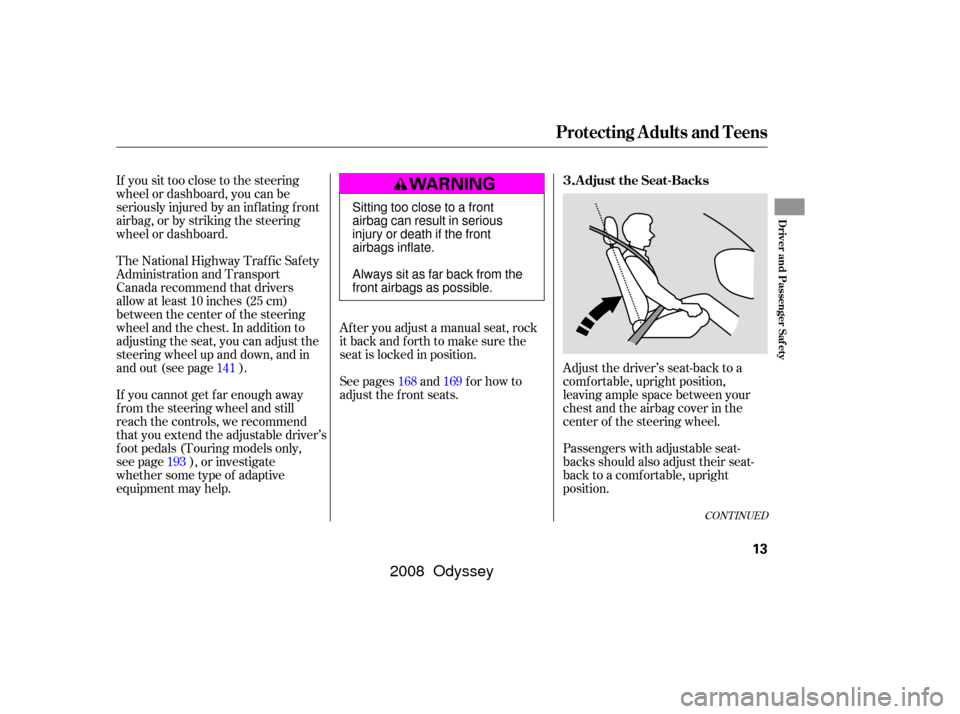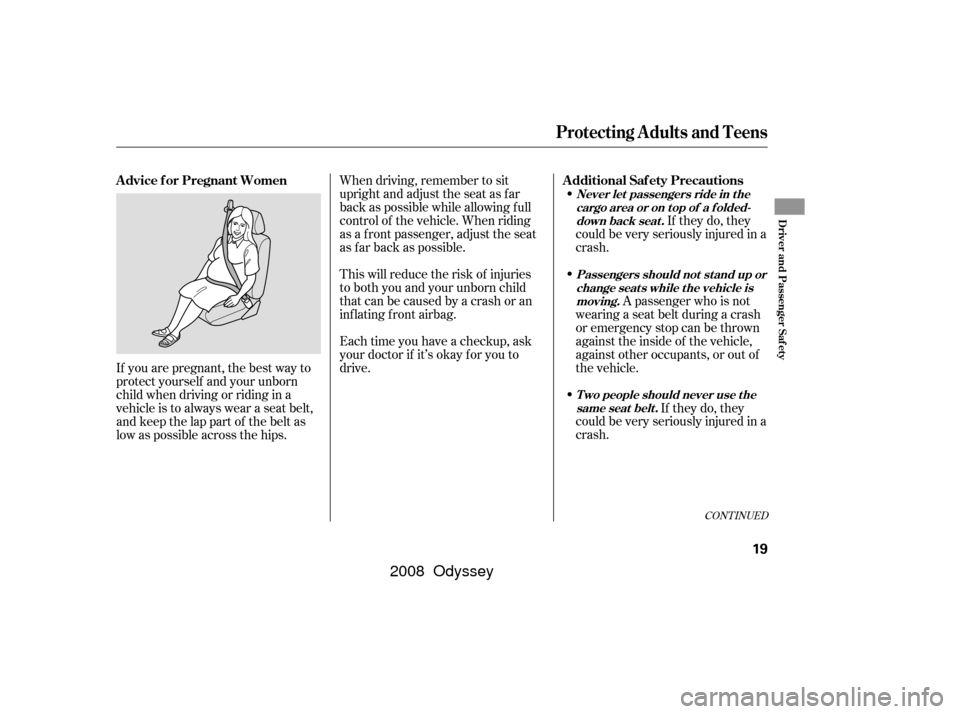Page 13 of 524

The most important things you need
to know about your airbags are:They are designed to supplement
the seat belts.
To do their job, airbags must
inf late with tremendous f orce. So
while airbags help save lives, they
can cause minor injuries or more
serious or even fatal injuries if
occupants are not properly
restrained or sitting properly. Always wear
your seat belt properly, and sit
upright and as f ar back f rom the
steering wheel as possible while
allowing f ull control of the vehicle. A
f ront passenger should move their
seat as far back from the dashboard
as possible. The rest of this section gives more
detailed inf ormation about how you
can maximize your saf ety.
Remember, however, that no saf ety
system can prevent all injuries or
deaths that can occur in a severe
crash, even when seat belts are
properly worn and the airbags deploy.
Your Vehicle’s Saf ety Features
Airbags do not replace seat belts.
A irbags of f er no prot ect ion in rearimpact s, or minor f ront al or sidecollisions.
Airbags can pose serious hazards. What you should do:
10
�����—�����—�����y���������������y���
�(�����������y�����
���y
2008 Odyssey
Page 16 of 524

If you sit too close to the steering
wheel or dashboard, you can be
seriously injured by an inf lating f ront
airbag, or by striking the steering
wheel or dashboard.Adjust the driver’s seat-back to a
comf ortable, upright position,
leaving ample space between your
chest and the airbag cover in the
center of the steering wheel.
Passengers with adjustable seat-
backs should also adjust their seat-
back to a comf ortable, upright
position.
The National Highway Traffic Safety
Administration and Transport
Canada recommend that drivers
allow at least 10 inches (25 cm)
between the center of the steering
wheel and the chest. In addition to
adjusting the seat, you can adjust the
steering wheel up and down, and in
and out (see page ).
If you cannot get f ar enough away
f rom the steering wheel and still
reach the controls, we recommend
that you extend the adjustable driver’s
f oot pedals (Touring models only,
see page ), or investigate
whether some type of adaptive
equipment may help.
See pages and for how to
adjust the f ront seats. After you adjust a manual seat, rock
it back and forth to make sure the
seat is locked in position.
141
193 168 169
CONT INUED
Adjust the Seat-Backs
3.
Protecting A dults and Teens
Driver and Passenger Saf ety
13
Sitting too close to a front
airbag can result in serious
injury or death if the front
airbags inflate.
Always sit as far back from the
front airbags as possible.
�����—�����—�����y���������������y���
�(�����������y�����
���y
2008 Odyssey
Page 21 of 524

After all occupants have adjusted
their seats and head restraints, and
put on their seat belts, it is very
important that they continue to sit
upright, well back in their seats, with
their feet on the floor, until the
vehicle is parked and the engine is
off.In addition, an occupant who is out of
position in the f ront seat can be
seriously or f atally injured in a crash
by striking interior parts of the
vehicle or being struck by an
inflating front airbag.
Sitting improperly can increase the
chance of injury during a crash. For
example, if an occupant slouches,
lies down, turns sideways, sits
forward, leans forward or sideways,
or puts one or both f eet up, the
chance of injury during a crash is
greatly increased. Maintain a Proper Sitting
Position
6.
Protecting A dults and Teens
18
Sitting improperly or out of
position can result in serious
injury or death in a crash.
Always sit upright, well back in
the seat, with your feet on the
floor.
�����—�����—�����y���������������y���
�(�����������y���������y
2008 Odyssey
Page 22 of 524

If you are pregnant, the best way to
protect yourself and your unborn
child when driving or riding in a
vehicle is to always wear a seat belt,
and keep the lap part of the belt as
low as possible across the hips.When driving, remember to sit
upright and adjust the seat as f ar
back as possible while allowing f ull
control of the vehicle. When riding
as a f ront passenger, adjust the seat
as far back as possible.
This will reduce the risk of injuries
to both you and your unborn child
that can be caused by a crash or an
inflating front airbag.
Each time you have a checkup, ask
your doctor if it’s okay f or you to
drive.
If they do, they
could be very seriously injured in a
crash.
A passenger who is not
wearing a seat belt during a crash
or emergency stop can be thrown
against the inside of the vehicle,
against other occupants, or out of
the vehicle.
If they do, they
could be very seriously injured in a
crash.
CONT INUED
Advice f or Pregnant Women Additional Saf ety Precautions
Never let passengers ride in t he
cargo area or on t op of a f olded-down back seat .
Passengers should not stand up orchange seats while the vehicle ismoving.
T wo people should never use t hesame seat belt .
Protecting A dults and Teens
Driver and Passenger Saf ety
19
�����—�����—�����y�����������
���y���
�(�����������y���������y
2008 Odyssey
Page 23 of 524

Carrying hard or sharp
objects on your lap, or driving with
a pipe or other sharp object in
your mouth, can result in injuries
if your f ront airbag inf lates.
If your
hands or arms are close to an
airbag cover, they could be injured
if the airbag inf lates. Objects on
the covers marked ‘‘SRS AIRBAG’’
could interf ere with the proper
operation of the airbags or be
propelled inside the vehicle and
hurt someone if the airbags inf late.
If a side airbag or a
side curtain airbag inf lates, a cup
holder or other hard object
attached on or near the door could
be propelled inside the vehicle and
hurt someone.
Devices intended to improve
occupant comf ort or reposition the
shoulder part of a seat belt can
reduce the protective capability of
thebeltandincreasethechanceof
serious injury in a crash.
Do not place hard or sharp object s
bet ween yourself and a f rontairbag.
K eep your hands and arms awayf rom t he airbag covers. Do not at t ach or place object s on
the f ront airbag covers.
Do not at t ach hard object s on ornear a door.
Do not put any accessories on seat
belts.
Protecting A dults and Teens
20
�����—�����—�����y���������������y���
�(�����������y���������y
2008 Odyssey
Page 24 of 524

This system uses the same sensors
as the front airbags to monitor
whether the f ront seat belts are
latched or unlatched, and how much
weight is on the f ront passenger’s
seat (see pages and).If either the driver or a f ront
passenger does not f asten their seat
belt while driving, the beeper will
sound and the indicator will f lash
again at regular intervals.
This system monitors the f ront seat
belts. If you turn the ignition switch
to the ON (II) position bef ore your
seat belt is f astened, the beeper will
sound and the indicator will f lash. If
your seat belt is not f astened bef ore
the beeper stops, the indicator will
stop f lashing but remain on.
If a f ront passenger does not f asten
their seat belt, the indicator will
come on about 6 seconds af ter the
ignition switch is turned to the ON
(II) position. The seat belt system
includes an indicator on the
instrument panel and a beeper to
remind you and your passengers to
f asten your seat belts.
You will also see a ‘‘FASTEN SEAT
BELT’’ or ‘‘FASTEN PASSENGER
SEAT BELT’’ message on the multi-
inf ormation display (see page ).
When no one is sitting in the f ront
passenger’s seat, or a child or small
adult is riding there, the indicator
should not come on and the beeper
should not sound.
Your seat belt system includes lap/
shoulder belts in all seating positions.
The f ront seat belts are also
equipped with automatic seat belt
tensioners.
88
30 31
CONT INUED
On Touring model
Seat Belt System Components
Additional Inf ormation About Your Seat Belts
Driver and Passenger Saf ety
21
�����—�����—�����y�������������
�y���
�(�����������y���������y
2008 Odyssey
Page 27 of 524

If a seat belt is worn during a crash,
it must be replaced by the dealer. A
belt that has been worn during a
crash may not provide the same level
of protection in a subsequent crash.
The dealer should also inspect the
anchors f or damage and replace
them if needed. If the automatic seat
belt tensioners activate during a
crash, they must be replaced.
For saf ety, you should check the
condition of your seat belts regularly.
Pull each belt out f ully, and look f or
f rays, cuts, burns, and wear. Check
that the latches work smoothly and
the belts retract easily. If a belt does
not retract easily, cleaning the belt
may correct the problem (see page
). Any belt that is not in good
condition or working properly will
not provide good protection and
should be replaced as soon as
possible.
Honda provides a limited warranty
on seat belts. See your booklet f or
details.
The tensioners are designed to
activate in any collision severe
enough to cause the f ront airbags to
deploy, or if a sensor detects your
vehicle is about to roll over (see page
).
The tensioners can also be activated
during a collision in which the f ront
airbags . In this case, the
airbags would not be needed, but the
additional restraint could be helpf ul. If a side airbag or side curtain airbag
deploys during a side impact, the
tensioner on that side of the vehicle
will also deploy.
When the tensioners are activated,
the seat belts will remain tight until
they are unbuckled. 33
436
Honda
Warranty Inf ormation
do not deploy
Additional Inf ormation About Your Seat Belts
Seat Belt Maintenance
24
Not checking or maintaining
seat belts can result in serious
injury or death if the seat belts
do not work properly when
needed.
Check your seat belts regularly
and have any problem
corrected as soon as possible.
�����—�����—�����y���������������y���
�(�����������y���������y
2008 Odyssey
Page 28 of 524
CONT INUED
A irbag System Components
Additional Inf ormation About Your Airbags
Driver and Passenger Saf ety
25
(8) Front Passenger’s Weight Sensors
(9) Front Impact Sensors
(10) Passenger Airbag Off Indicator
(11) Side Impact Sensors (1) Driver’s Front Airbag
(2) Passenger’s Front Airbag
(3) Control Unit
(4) Front Seat Belt Tensioners
(5) Side Airbags
(6) Side Curtain Airbags
(7) Driver’s Seat Position Sensor
(15) Supplemental Restraint System(SRS) Indicator
(12) Occupant Position Detection
System (OPDS) Sensors
(13) Front Passenger’s Weight Sensors/ OPDS Sensors Control Unit
(14) Rear Safing Sensor
(9) (2)
(15) (5)
(11)
(4) (11)
(6)
(11)
(14)
(11)
(1)
(3) (11) (4)
(7) (11) (8)
(5) (12)
(13)
(10)
�����—�����—�����y���������������y���
�(�����������y���������y
2008 Odyssey